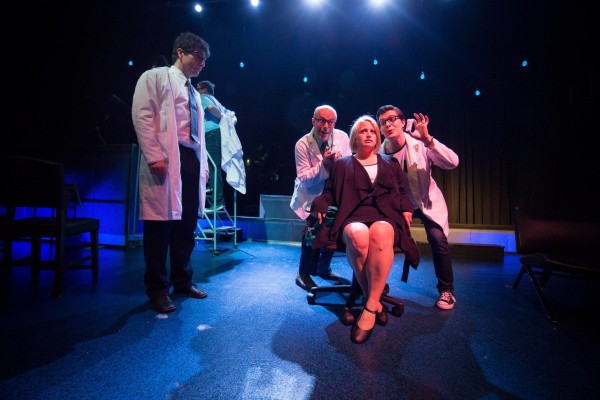
The Highland Arts Theatre finishes off its 2017 Winter/Spring season with a bang: an exhilarating, heart-wrenching production of the award-winning Broadway musical, next to normal.
The Goodmans are a perfectly normal suburban family: father Dan commutes to work in the morning, mother Diana makes sandwiches for school lunches, teenaged son Gabe keeps his mom up worrying when he rolls in after midnight, and his younger sister Natalie seethes with resentment and sarcasm from perpetually running a distant second to her brother. Typical.
But one of these characters has a chronic mental health issue that threatens—not the peace and happiness of the Goodmans, no, they’ve known little of that—but the fact they will survive as a family let alone become anything close to next to normal.
HAT artistic director Wesley Colford introduced the play and addressed the audience explaining how all of the plays in this particular season were purposefully offered to de-stigmatize certain issues that normally (or next to normally) don’t get addressed on stage. Some audience members over the past few months had issues with not only that subject matter but the sometimes strong language used on stage. In promoting the HAT’s upcoming summer season, he assured audience members the language of the plays would be “PG-rated”.
At the close of Wednesday night’s opening performance, the entire audience rose together in an ovation for the entire production: quite a testimonial for a play that challenges the idea of a cozy evening at the theatre. The play explores not only one individual’s battle with mental illness, but loss, grief, alienation, the stress of sharing one’s life with a person with mental illness, the consequences of the hit or miss therapies of treatment, the agonies of adolescence, and a multitude of other problems not usually wrapped inside a propulsive rock/pop score.
The next morning, a woman I know, who attended the play, came up to me in a coffee shop to say what a great play and a great production the HAT’s show was. She had attended with two friends who were nurses who said the play’s treatment of mental illness and its effects, with book and lyrics by Brian Yorkey and music by Tom Kitt, were dead on accurate.
So, maybe the HAT’s ambition to de-stigmatize difficult issues did pay off.
Certainly nobody could fault the performers.
Heather Merrill, as the beleaguered Diana, has the torchy, bold voice to carry the wide emotional range of her character. She also has the acting chops to engage the audience in Diana’s journey. Marty Burt, as Dan, had vulnerability in his singing role, and a “can do” optimism in his dramatic scenes of a man barely holding things together.
Alison Crosby, as Natalie (she shares the role with Emily O’Leary on alternating nights), had a wonderful ability to sound genuinely snarky and wounded at the same time and her singing, while assured, had a plaintive undertone of chronic heartbreak (especially in one of the standout songs in the score, “Superboy and the Invisible Girl”). Brandon Carabin, as Gabe, had the cockiness of a teenage boy and a more than ideal tenderness in his relationship with his mom. He also had a rock star moment with his electrifying performance of “I’m Alive”.
Colford appeared as Natalie’s boyfriend, Henry, and one could not help but see it as yet another variation of his several characters in last month’s The Watson Intelligence: kind, patient, full of love and good intentions. But Henry was his own man here and Colford made him a three dimensional character. Ron Newcombe, as a pair of psychiatrists was handed a tall order—the neutral observer who furthers the story– that he carried out with great poise: he even had a couple of hilarious rock star moments of his own.
This is director Ron Jenkins third production for the HAT and it combines the brutal honesty of his own Extinction Song (about the son of an alcoholic father) and the warmth of Sucker (about a brother and sister coping with the loss of their parents). Like both of those productions, he guided his cast to make every moment count, both in emotional force and story-telling verve. This play never slowed down from beginning to end and even the quieter moments had a heart-pounding sense of urgency. He also used Bradley Murphy’s set design (a variety of platforms and open spaces with a few set pieces to define them) and Ken Heaton’s ambient use of lighting design to whisk the audience through an ever escalating series of family crises.
The play is almost entirely musical, almost closer to being a kind of pop opera, and that made musical director Barb Stetter’s contribution a vital part of its success. Besides achieving astounding vocal performances from her cast, Stetter led her six member pit band through a note perfect performance of a difficult score.
next to normal does not offer any easy answers to the problems of mental illness because there are none. But, thanks to some brilliant performances and direction and music, it guides its audience to consider how one may go about keeping one’s sanity without losing one’s humanity.
next to normal runs at 8 pm nightly at the Highland Arts Theatre on Sydney’s Bentinck Street until Wednesday, May 24.

